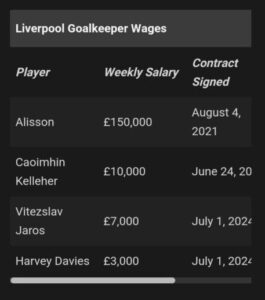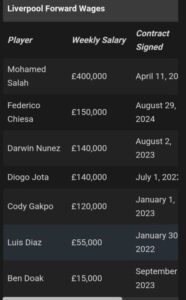
Over the past decade, Liverpool have seemingly won everything under the sun. But while a sixth Champions League high point and a first Premier League title in 30 years already seemed impressive enough, the fact that the Jurgen Klopp era reached such unprecedented pinnacles all while operating with a net spend far inferior to their rivals, the Reds’ recent success stories are only enriched markedly more.
Under FSG’s conscientious yet accomplished ownership, Liverpool have often been lauded for their business strategy that has seen the club maintain a solid financial footing. Whereas other owners of top European clubs cast a fearful glance over their shoulders at past devil-may-care transfer policies, the Reds straddle far away from Financial Fair Play regulations that are catching out the likes of Chelsea and Manchester City.
In spite of that, though, their loyalty to long-serving players means their wage bill can be pretty restrictive at times, with 12 players earning at least £100,000-per-week. Using Capology to collect the rest of the data, every Liverpool player’s wages have been looked at – and the reading still makes for a refreshing sight for those fed up with football’s ugly, money-spinning side.
Goalkeepers
Liverpool’s glove-bearers boast the club’s prudence best

Alisson is one of the best goalkeepers in world football. Yet, despite this global recognition, his weekly wage of £150,000 doesn’t even rank him among the top 10 highest-paid goalkeepers. Instead, this list is topped by Manuel Neuer, who earns a whopping £353,000-a-week.
The Brazilian has saved his side on countless occasions, and thus, a more hefty payout at the end of every week would be more than justifiable. However, no better place is Liverpool’s money-savvy ways better highlighted than with the little amount they spend on their goalkeeper unit.
Caoimhin Kelleher is arguably the best backup glove-bearer in the league, with his octopus-like saves meaning his club are always in safe hands should opposition forwards somehow bypass Virgil van Dijk. Astonishingly, though, the Irish international earns just £10,000-per-week, which means he is the Reds’ second-lowest earner, ahead of only fellow goalkeeper Vitezslav Jaros, who made his Premier League debut against Crystal Palace in a 1-0 away victory after replacing the injured Alisson.

Defenders
Virgil Van Dijk and Trent Alexander-Arnold are the club’s 2nd and 3rd chief earners

The trend of Liverpool acquiring the services of players who are easily among the best in their position continues through Virgil Van Dijk and Trent Alexander-Arnold. But unlike the case with their goalkeeping teammate, both these players – who have been prominent in the Reds’ recent trophy hauls – earn a far more suitable weekly wage.
Van Dijk earns the second most of any of his teammates by bringing home £350,000 every week after putting pen to paper on a new deal, while his right-back partner rakes in a respectable £180,000-per-week. Andrew Robertson completes a trilogy of defenders who earn a six-digit wage, as the Scotland captain boasts a weekly pay of £160,000.
Van Dijk’s most trusted centre-back companion, Ibrahima Konate, is on £70,000-per-week, which is a sizeable £40,000 more than youngster, Jarell Quansah, who has seen his game time drop since Arne Slot’s arrival in the summer.

Midfielders
All four of Klopp’s midfield acquisitions from 2023 earn more than longer servants

Midfield was Liverpool’s biggest deficiency two years ago, with big earners James Milner, Fabinho, and club captain Jordan Henderson all heading out of the fire exit. But the club saw even more arrivals come in the other way, as Klopp brought in Wataru Endo, Dominik Szoboszlai, Ryan Gravenberch, and World Cup winner Alexis Mac Allister to heed the losses.
For the most part, it has been successful, with Mac Allister impressing in his first campaign at the club and Gravenberch now shining under Arne Slot. Szoboszlai earns £120,000-per-week, which concludes the six-digit earners in midfield, while it’s safe to say the club have been wise elsewhere in midfield, with the five other players earning £50,000 or less.

Forwards
Mo Salah is deservedly the club’s primary wage earner

Certainly, there probably wasn’t any surprise that Mo Salah is his club’s chief bread-winner, earning an eye-watering £400,000-per-week – which helped him stay put on Merseyside amid growing interest from Saudi Arabia. But as the ‘Egyptian King’ is also the Reds’ primary source of goals, who could blame the club for wanting to retain his services?
Perhaps one surprise is the wide gulf between him and the rest of his attacking cohort. Diogo Jota and Darwin Nunez earn £140,000-a-week, while Federico Chiesa, Liverpool’s most recent addition in attack, signed a four-year deal worth £150,000-a-week, although he has quickly become one of the worst transfers of the window.
Quite astoundingly, Luis Diaz only rakes in a weekly payout of £55,000. The Colombian is showing he deserves a hefty pay-rise with a string of impressive performances in 24/25.

